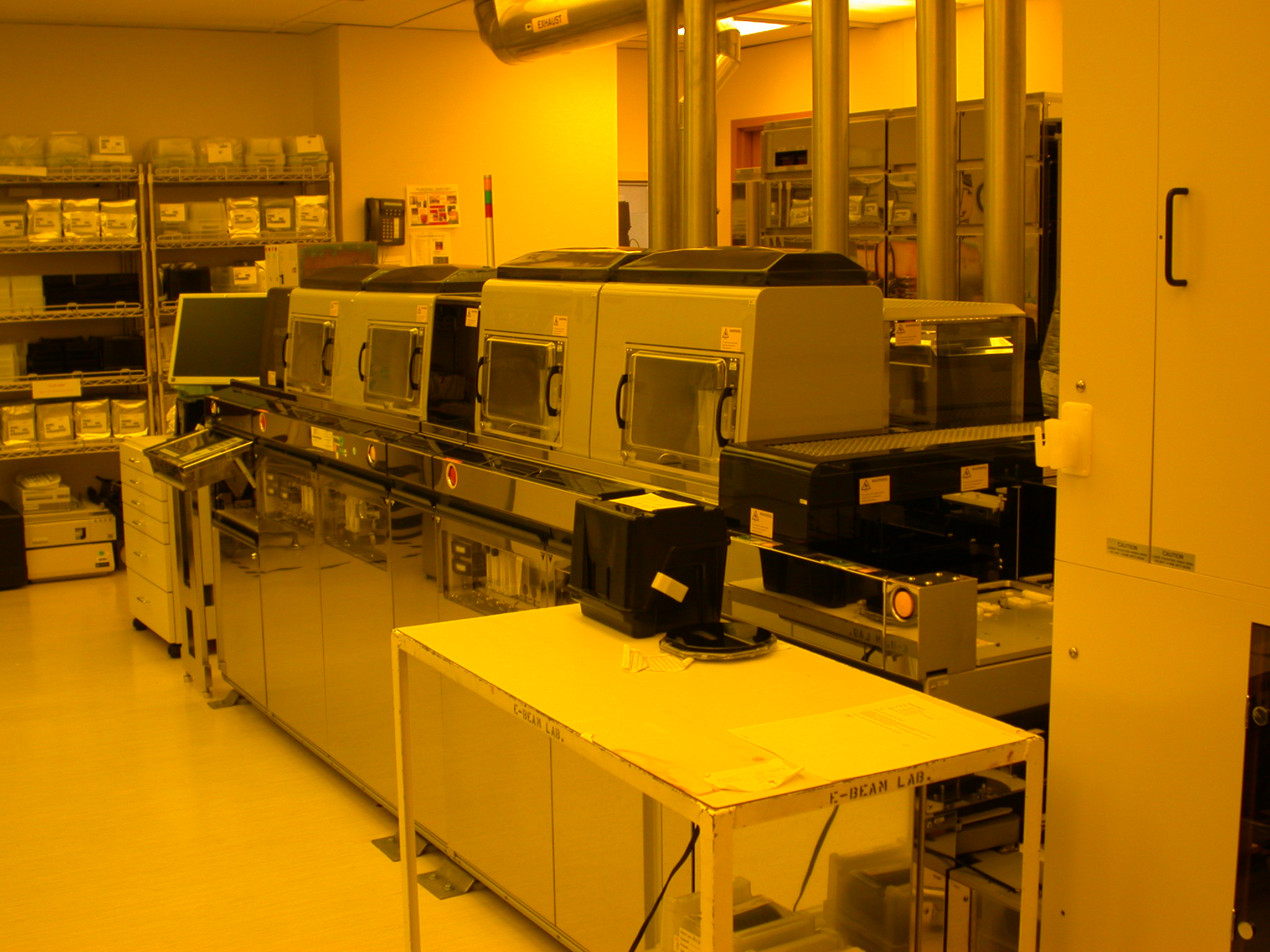|
Self-aligned Gate
In semiconductor electronics fabrication technology, a self-aligned gate is a transistor manufacturing approach whereby the gate electrode of a MOSFET (metal–oxide–semiconductor field-effect transistor) is used as a mask for the doping of the source and drain regions. This technique ensures that the gate is naturally and precisely aligned to the edges of the source and drain. The use of self-aligned gates in MOS transistors is one of the key innovations that led to the large increase in computing power in the 1970s. Self-aligned gates are still used in most modern integrated circuit processes. Introduction IC construction Integrated circuits (ICs, or "chips") are produced in a multi-step process that builds up multiple layers on the surface of a disk of silicon known as a " wafer". Each layer is patterned by coating the wafer in photoresist and then exposing it to ultraviolet light being shone through a stencil-like "mask". Depending on the process, the photoresist that ... [...More Info...] [...Related Items...] OR: [Wikipedia] [Google] [Baidu] |
Semiconductor Device Fabrication
Semiconductor device fabrication is the process used to manufacture semiconductor devices, typically integrated circuits (ICs) such as microprocessors, microcontrollers, and memories (such as Random-access memory, RAM and flash memory). It is a multiple-step Photolithography, photolithographic and physico-chemical process (with steps such as thermal oxidation, thin-film deposition, ion-implantation, etching) during which electronic circuits are gradually created on a wafer (electronics), wafer, typically made of pure single-crystal semiconducting material. Silicon is almost always used, but various compound semiconductors are used for specialized applications. This article focuses on the manufacture of integrated circuits, however steps such as etching and photolithography can be used to manufacture other devices such as LCD and OLED displays. The fabrication process is performed in highly specialized semiconductor fabrication plants, also called foundries or "fabs", with the cen ... [...More Info...] [...Related Items...] OR: [Wikipedia] [Google] [Baidu] |
Parasitic Capacitance
Parasitic capacitance or stray capacitance is the unavoidable and usually unwanted capacitance that exists between the parts of an electronic component or circuit simply because of their proximity to each other. When two electrical conductors at different voltages are close together, the electric field between them causes electric charge to be stored on them; this effect is capacitance. All practical circuit elements such as inductors, diodes, and transistors have internal capacitance, which can cause their behavior to depart from that of ideal circuit elements. Additionally, there is always some capacitance between any two conductors; this can be significant with closely spaced conductors, such as adjacent wires or printed circuit board traces. The parasitic capacitance between the turns of an inductor (e.g. Figure 1) or other wound component is often described as ''self-capacitance''. However, in electromagnetics, the term self-capacitance more correctly refers to a diffe ... [...More Info...] [...Related Items...] OR: [Wikipedia] [Google] [Baidu] |
Fairchild Semiconductor
Fairchild Semiconductor International, Inc. was an American semiconductor company based in San Jose, California. It was founded in 1957 as a division of Fairchild Camera and Instrument by the " traitorous eight" who defected from Shockley Semiconductor Laboratory. It became a pioneer in the manufacturing of transistors and of integrated circuits. Schlumberger bought the firm in 1979 and sold it to National Semiconductor in 1987; Fairchild was spun off as an independent company again in 1997. In September 2016, Fairchild was acquired by ON Semiconductor. The company had locations in the United States at San Jose, California; San Rafael, California; South Portland, Maine; West Jordan, Utah; and Mountaintop, Pennsylvania. Outside the US, it operated locations in Australia; Singapore; Bucheon, South Korea; Penang, Malaysia; Suzhou, China; and Cebu, Philippines, among others. History 1950s In 1955, William Shockley founded Shockley Semiconductor Laboratory, funded by ... [...More Info...] [...Related Items...] OR: [Wikipedia] [Google] [Baidu] |
MOS Integrated Circuit
upright=1.4, gate oxide">insulating layer (pink). The MOSFET (metal–oxide–semiconductor field-effect transistor) is a type of insulated-gate field-effect transistor (IGFET) that is fabricated by the controlled oxidation of a semiconductor, typically silicon. The voltage of the covered gate determines the electrical conductivity of the device; this ability to change conductivity with the amount of applied voltage can be used for amplifying or switching electronic signals. The MOSFET is the basic building block of most modern electronics, and the most frequently manufactured device in history, with an estimated total of 13 sextillion (1.3 × 1022) MOSFETs manufactured between 1960 and 2018. It is the most common semiconductor device in digital and analog circuits, and the most common power device. It was the first truly compact transistor that could be miniaturized and mass-produced for a wide range of uses. MOSFET scaling and miniaturization has been driving the ... [...More Info...] [...Related Items...] OR: [Wikipedia] [Google] [Baidu] |
Low Threshold Voltage
The threshold voltage, commonly abbreviated as Vth or VGS(th), of a field-effect transistor (FET) is the minimum gate-to-source voltage (VGS) that is needed to create a conducting path between the source and drain terminals. It is an important scaling factor to maintain power efficiency. When referring to a junction field-effect transistor (JFET), the threshold voltage is often called pinch-off voltage instead. This is somewhat confusing since ''pinch off'' applied to insulated-gate field-effect transistor (IGFET) refers to the channel pinching that leads to current saturation behavior under high source–drain bias, even though the current is never off. Unlike ''pinch off'', the term ''threshold voltage'' is unambiguous and refers to the same concept in any field-effect transistor. Basic principles In n-channel ''enhancement-mode'' devices, a conductive channel does not exist naturally within the transistor. With no VGS, dopant ions added to the body of the FET form a region ... [...More Info...] [...Related Items...] OR: [Wikipedia] [Google] [Baidu] |
Robert W
The name Robert is an ancient Germanic given name, from Proto-Germanic "fame" and "bright" (''Hrōþiberhtaz''). Compare Old Dutch ''Robrecht'' and Old High German ''Hrodebert'' (a compound of '' Hruod'' () "fame, glory, honour, praise, renown, godlike" and ''berht'' "bright, light, shining"). It is the second most frequently used given name of ancient Germanic origin.Reaney & Wilson, 1997. ''Dictionary of English Surnames''. Oxford University Press. It is also in use as a surname. Another commonly used form of the name is Rupert. After becoming widely used in Continental Europe, the name entered England in its Old French form ''Robert'', where an Old English cognate form (''Hrēodbēorht'', ''Hrodberht'', ''Hrēodbēorð'', ''Hrœdbœrð'', ''Hrœdberð'', ''Hrōðberχtŕ'') had existed before the Norman Conquest. The feminine version is Roberta. The Italian, Portuguese, and Spanish form is Roberto. Robert is also a common name in many Germanic languages, including En ... [...More Info...] [...Related Items...] OR: [Wikipedia] [Google] [Baidu] |
Aluminum-gate
A metal gate, in the context of a lateral metal–oxide–semiconductor (MOS) stack, is the gate electrode separated by an oxide from the transistor's channel – the gate material is made from a metal. In most MOS transistors since about the mid-1970s, the "M" for metal has been replaced by polysilicon, but the name remained. Aluminum gate The first MOSFET (metal–oxide–semiconductor field-effect transistor) was made by Mohamed Atalla and Dawon Kahng at Bell Labs in 1959, and demonstrated in 1960. They used silicon as channel material and a non-self-aligned aluminum gate. Aluminum gate metal (typically deposited in an evaporation vacuum chamber onto the wafer surface) was common through the early 1970s. Polysilicon By the late 1970s, the industry had moved away from aluminum as the gate material in the metal–oxide–semiconductor stack due to fabrication complications and performance issues. A material called polysilicon (polycrystalline silicon, highly doped with donors ... [...More Info...] [...Related Items...] OR: [Wikipedia] [Google] [Baidu] |
Metal Gate
A metal gate, in the context of a lateral metal–oxide–semiconductor (MOS) stack, is the gate electrode separated by an oxide from the transistor's channel – the gate material is made from a metal. In most MOS transistors since about the mid-1970s, the "M" for metal has been replaced by polysilicon, but the name remained. Aluminum gate The first MOSFET (metal–oxide–semiconductor field-effect transistor) was made by Mohamed Atalla and Dawon Kahng at Bell Labs in 1959, and demonstrated in 1960. They used silicon as channel material and a non-self-aligned aluminum gate. Aluminum gate metal (typically deposited in an evaporation vacuum chamber onto the wafer surface) was common through the early 1970s. Polysilicon By the late 1970s, the industry had moved away from aluminum as the gate material in the metal–oxide–semiconductor stack due to fabrication complications and performance issues. A material called polysilicon ( polycrystalline silicon, highly doped wit ... [...More Info...] [...Related Items...] OR: [Wikipedia] [Google] [Baidu] |
Photolithography
Photolithography (also known as optical lithography) is a process used in the manufacturing of integrated circuits. It involves using light to transfer a pattern onto a substrate, typically a silicon wafer. The process begins with a photosensitive material, called a photoresist, being applied to the substrate. A photomask that contains the desired pattern is then placed over the photoresist. Light is shone through the photomask, exposing the photoresist in certain areas. The exposed areas undergo a chemical change, making them either soluble or insoluble in a developer solution. After development, the pattern is transferred onto the substrate through etching, chemical vapor deposition, or ion implantation processes. Ultraviolet, Ultraviolet (UV) light is typically used. Photolithography processes can be classified according to the type of light used, including ultraviolet lithography, deep ultraviolet lithography, extreme ultraviolet lithography, extreme ultraviolet lithography ... [...More Info...] [...Related Items...] OR: [Wikipedia] [Google] [Baidu] |
Polycrystalline Silicon
Polycrystalline silicon, or multicrystalline silicon, also called polysilicon, poly-Si, or mc-Si, is a high purity, polycrystalline form of silicon, used as a raw material by the solar photovoltaic and electronics industry. Polysilicon is produced from metallurgical grade silicon by a chemical purification process, called the Siemens process. This process involves distillation of volatile silicon compounds, and their decomposition into silicon at high temperatures. An emerging, alternative process of refinement uses a fluidized bed reactor which is lower cost. The photovoltaic industry also produces upgraded metallurgical-grade silicon (UMG-Si), using metallurgical instead of chemical purification processes for lower cost at the expense of purity. When produced for the electronics industry, polysilicon contains impurity levels of less than one part per billion (ppb), while polycrystalline solar grade silicon (SoG-Si) is generally less pure. In the 2010's, production shifted ... [...More Info...] [...Related Items...] OR: [Wikipedia] [Google] [Baidu] |
Charge-coupled Device
A charge-coupled device (CCD) is an integrated circuit containing an array of linked, or coupled, capacitors. Under the control of an external circuit, each capacitor can transfer its electric charge to a neighboring capacitor. CCD sensors are a major technology used in digital imaging. Overview In a CCD image sensor, pixels are represented by Doping (semiconductor), p-doped metal–oxide–semiconductor (MOS) capacitors. These MOS capacitors, the basic building blocks of a CCD, are biased above the threshold for inversion when image acquisition begins, allowing the conversion of incoming photons into electron charges at the semiconductor-oxide interface; the CCD is then used to read out these charges. Although CCDs are not the only technology to allow for light detection, CCD image sensors are widely used in professional, medical, and scientific applications where high-quality image data are required. In applications with less exacting quality demands, such as consumer and pr ... [...More Info...] [...Related Items...] OR: [Wikipedia] [Google] [Baidu] |








